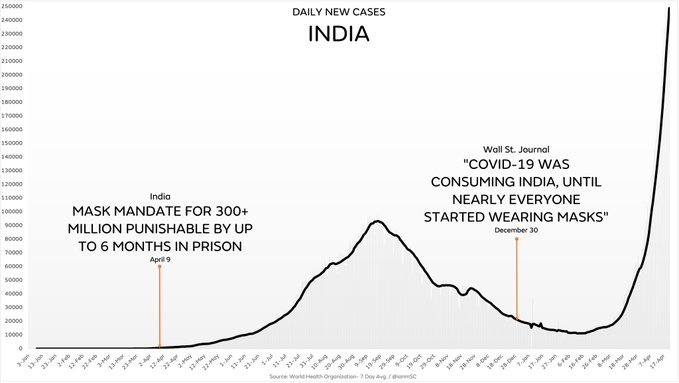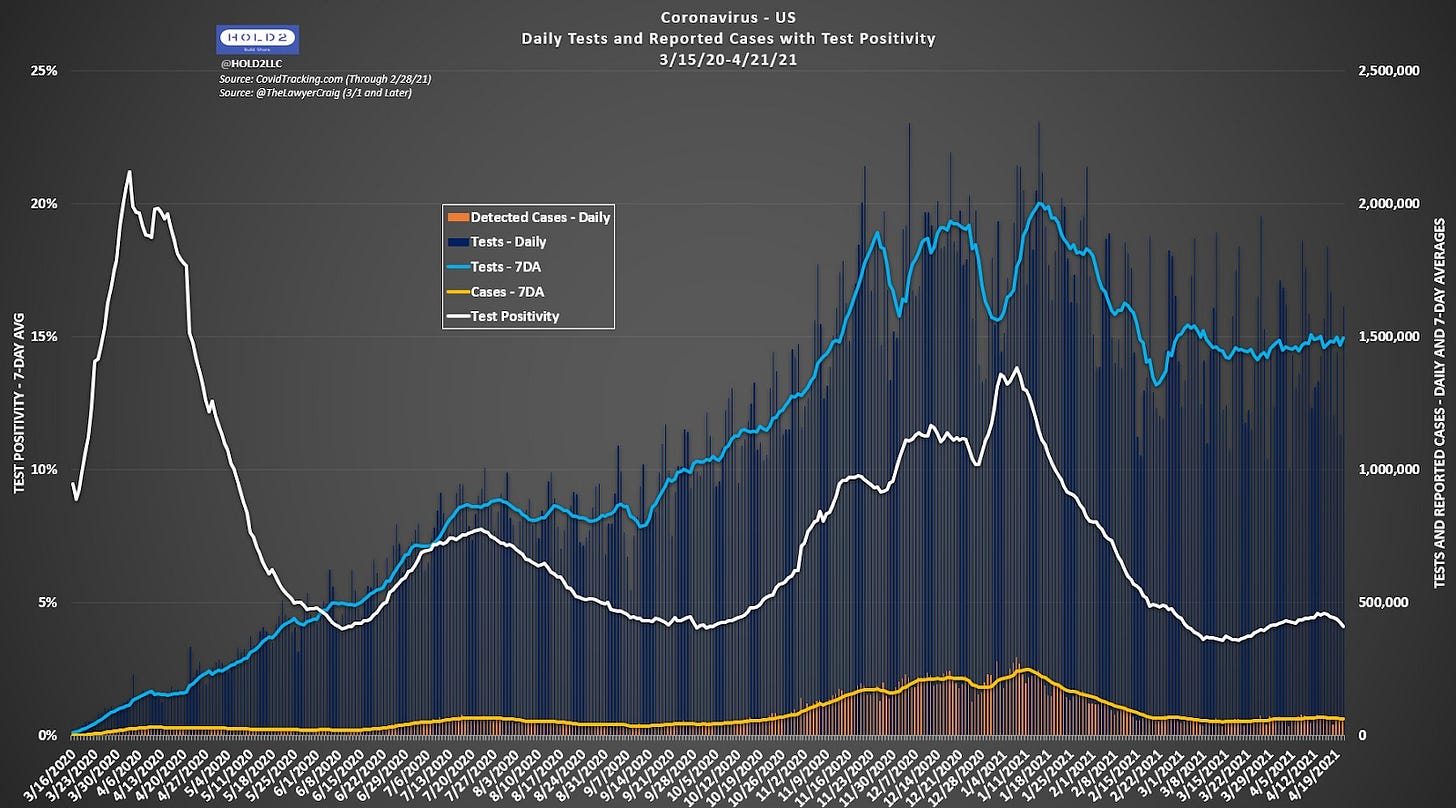Is There a Path Out of Lockdown?
As vaccination numbers keep increasing, the discussion is moving toward a path out of lockdown and restrictions. In California, vaccinated teachers are using medical exemptions to continue remote learning. Elsewhere, restrictions continue to lift, but there isn’t a consensus about continuing to wear masks.
In other news:
Governments need to give Americans an off-ramp to the post-pandemic world. Ending outdoor mask requirements would be a good place to start, says Derek Thompson in The Atlantic.
Tom Woods interviews Great Barrington Declaration co-author Jay Bhattacharya on the new COVID variants, science and censorship, and the problems with vaccine passports.
Newly identified COVID cases in Texas have fallen by more than 50 percent, and daily deaths have dropped even more. But cases are rising mainly in states with stricter disease control policies, says Jacob Sullum in Reason Magazine.
Jeffrey A. Tucker at AIER analyzes the failure of lockdowns, pointing out that “the problem is that the presence or absence of lockdowns in the face of the virus seem completely uncorrelated with any disease trajectory”.
Want to support our work? Visit our Substack page and leave us a tip.
COVID News
S.F. students face ‘Zoom in a room’ at schools after 500 educators granted medical exemptions
https://www.sfchronicle.com/education/article/S-F-students-face-Zoom-in-a-room-at-16118345.php
Thousands of San Francisco students heading back to their classrooms this month will be carrying their computers to school each day and sitting in front of a screen to learn from their teachers — who will remain at home.
That’s because nearly 500 district teachers and classroom aides scheduled to return to in-person instruction won’t because they have a medical exemption, allowing them to continue teaching online even if their students are at school, where they are supervised by a credentialed substitute or other qualified staff member.
That’s an estimated 10% of eligible educators.
A Covid-19 Lesson for the U.S. From Three Countries With Rapid Vaccination Rollouts
Rapid Covid-19 vaccination rollouts in Israel, the U.K. and Chile hold an important lesson for the U.S. as it navigates back to normalcy: Risks remain, even after inoculating a significant share of your population.
The three countries have so far had contrasting experiences. Israel has reopened its economy and is closing down its Covid-19 treatment wards. Chile, by contrast, has locked down again and shut its borders. The U.K. is taking it slow, with a staged reopening planned over the next few months.
Epidemiologists say the risk is real of a so-called exit wave of new infections as countries drop their guard while shots increase, since vaccines don’t provide 100% protection against contracting Covid-19. New coronavirus variants that can evade the immunity conferred by vaccination or past infection heighten the risk of another surge.
Coronavirus cases aren't budging — even after vaccinations doubled
https://news.yahoo.com/coronavirus-cases-arent-budging-even-090016590.html
The U.S. is pumping out coronavirus vaccines by the millions, but the coronavirus isn’t slowing down.
The big picture: This spring has seen a surge in vaccinations but almost no change in the coronavirus’ spread, leaving the U.S. with an outbreak that’s still too big.
Where it stands: In the last week of February, the U.S. was averaging 65,686 new coronavirus cases per day. Now, eight weeks later, we’re averaging 64,814 new cases per day.
And yet, over the same eight-week period, the U.S. has administered more than 65 million vaccine doses — roughly doubling the number of Americans who have gotten at least one shot.
Gov. Cooper anticipates social distancing, mass gathering restrictions lifted by June 1; mask should still be worn
CHARLOTTE, N.C. — North Carolina Gov. Roy Cooper said Wednesday afternoon that, with increasing vaccinations and ongoing work to slow the spread of COVID-19, he anticipates the state be able to lift all mandatory social distancing, capacity and mass gathering restrictions by June 1.
Cooper said he plans to issue an Executive Order next week outlining safety restrictions for the month of May.
Cooper stressed that North Carolinians need to remain vigilant in the fight against COVID-19.
"We need everyone to step up," Cooper said.
Health Secretary Dr. Mandy Cohen warned that masks will still be important until the state reaches a target of two-thirds of the adult population vaccinated. Right now, roughly 47% of adults have received at least one vaccine. Just over one-third, 35.8%, of adults are fully vaccinated against COVID-19.
Commentary/Analysis
Are Outdoor Mask Mandates Still Necessary?
https://www.theatlantic.com/ideas/archive/2021/04/are-outdoor-mask-mandates-still-necessary/618626/
Last week, I covered my nose and mouth with close-fitting fabric like a good citizen and walked to a restaurant in Washington, D.C., where I de-masked at a patio table to greet a friend. I sat with my chair facing the entrance and watched dozens of people perform the same ritual, removing a mask they’d worn outside and alone. It seemed like the most normal thing in the world. Until, suddenly, it seemed very weird.
The coronavirus is most transmissible in poorly ventilated indoor spaces, where the aerosolized virus can linger in the air before latching onto our nasal or bronchial cells. In outdoor areas, the viral spray is more likely to disperse. One systematic overview of COVID-19 case studies concluded that the risk of transmission was 19 times higher indoors than outside. That’s why wearing a mask is so important in, say, a CVS, but less crucial in, say, the park.
At the restaurant, however, I saw an inversion of this rule. Person after person who’d dutifully worn a mask on the uncrowded street took it off to sit still, in close proximity to friends, and frequently inside. I felt like I was watching people put on their seatbelts in parked cars, then unbuckle them just as they put the vehicle in drive.
Ep. 1878 Jay Bhattacharya on Variants, Vaccine Passports, and the Future
http://tomwoods.com/ep-1878-jay-bhattacharya-on-variants-vaccine-passports-and-the-future/
Stanford’s Jay Bhattacharya covers a wide range of issues in this episode: asymptomatic transmission and how common (or otherwise) it is, how concerned people should be about the variants, what the prospects are for fall and winter, YouTube censorship, what his opinions are of the vaccines, the problems with “vaccine passports,” and more.
The COVID-19 Disaster That Did Not Happen in Texas
https://reason.com/2021/04/21/the-covid-19-disaster-that-did-not-happen-in-texas/
When Texas Gov. Greg Abbott, a Republican, lifted his statewide face mask mandate and his limits on business occupancy in early March, Democrats warned that he was inviting a public health disaster. Yet a month and a half later, newly identified coronavirus cases in Texas have fallen by more than 50 percent, and daily deaths have dropped even more.
The Lockdown Paradigm is Collapsing
https://www.aier.org/article/the-lockdown-paradigm-is-collapsing/
It’s taken much longer than it should have but at last it seems to be happening: the lockdown paradigm is collapsing. The signs are all around us.
The one-time hero of the lockdown, New York Governor Andrew Cuomo, has seen his support tank from 71% to 38%, along with ever more demands that he resign. Meanwhile, polls have started to favor Florida governor and lockdown opponent Ron DeSantis for influence over the GOP in the future. This remarkable flip in fortunes is due to the dawning realization that the lockdowns were a disastrous policy. DeSantis and fellow anti-lockdown governor Kristi Noem are the first to state the truth bluntly. Their honesty has won them both credibility.
Meanwhile, in Congressional hearings, Representative James Jordan (R-OH) demanded that Dr. Fauci account for why closed Michigan has worse disease prevalence than neighboring Wisconsin which has long been entirely open. Fauci pretended he couldn’t hear the question, couldn’t see the chart, and then didn’t understand. Finally he just sat there silent after having uttered a few banalities about enforcement differentials.
Research
SARS-CoV-2 Cardiac Involvement in Young Competitive Athletes
https://www.ahajournals.org/doi/abs/10.1161/CIRCULATIONAHA.121.054824
Abstract
Background: Cardiac involvement among hospitalized patients with severe acute respiratory syndrome coronavirus 2 (SARS-CoV-2) is common and associated with adverse outcomes. The objective of this study was to determine the prevalence and clinical implications of SARS-CoV-2 cardiac involvement in young competitive athletes.
Methods: In this prospective multicenter observational cohort study with data from 42 colleges/universities, we assessed the prevalence, clinical characteristics, and outcomes of SARS-CoV-2 cardiac involvement among collegiate athletes in the United States. Data were collected from September 1, 2020 to December 31, 2020. The primary outcome was the prevalence of definite, probable, or possible SARS-CoV-2 cardiac involvement based on imaging definitions adapted from the Updated Lake Louise Criteria. Secondary outcomes included the diagnostic yield of cardiac testing, predictors for cardiac involvement, and adverse cardiovascular events or hospitalizations.
Results: Among 19,378 athletes tested for SARS-CoV-2 infection, 3018 (mean age 20 years [SD,1 year]; 32% female) tested positive and underwent cardiac evaluation. A total of 2820 athletes underwent at least one element of cardiac 'triad' testing [12-lead electrocardiography (ECG), troponin, and/or transthoracic echocardiography(TTE)] followed by cardiac magnetic resonance (CMR) if clinically indicated. In contrast, primary screening CMR was performed in 198 athletes. Abnormal findings suggestive of SARS-CoV-2 cardiac involvement were detected by ECG (21/2999,0.7%), cardiac troponin (24/2719,0.9%), and TTE (24/2556,0.9%). Definite, probable, or possible SARS-COV-2 cardiac involvement was identified in 21/3018 (0.7%) athletes, including 15/2820 (0.5%) who underwent clinically indicated CMR (n=119) and 6/198 (3.0%) who underwent primary screening CMR. Accordingly, the diagnostic yield of CMR for SARS-COV-2 cardiac involvement was 4.2 times higher for a clinically indicated CMR (15/119,12.6%) versus a primary screening CMR (6/198,3.0%). After adjustment for race and sex, predictors of SARS-CoV-2 cardiac involvement included cardiopulmonary symptoms (OR:3.1,95% CI:1.2,7.7) or at least one abnormal triad test (OR:37.4,95% CI:13.3,105.3). Five (0.2%) athletes required hospitalization for non-cardiac complications of SARS-CoV-2. During clinical surveillance (median follow-up 113 days [IQR=90,146]), there was one (0.03%) adverse cardiac event likely unrelated to SARS-CoV-2 infection.
Conclusions: SARS-CoV-2 infection among young competitive athletes is associated with a low prevalence of cardiac involvement and a low risk of clinical events in short term follow-up.
Charts and Graphics
International News
India sets a global record for daily infections
https://www.nytimes.com/2021/04/22/world/india-coronavirus-record.html
India’s rapidly worsening coronavirus outbreak is now expanding on a scale beyond any previously measured in more than a year of the pandemic: The health ministry reported more than 310,000 new infections on Thursday, the most recorded in any country on a single day.
India’s total eclipsed the previous one-day high of 300,669 recorded coronavirus cases, set in the United States on Jan. 8, according to a New York Times database, though differences in testing levels from country to country, and a widespread lack of tests early in the pandemic, make comparisons difficult.
Over the past two months, the outbreak in India has exploded, with reports of superspreader gatherings, oxygen shortages and ambulances lined up outside hospitals because there were no ventilators for new patients.






